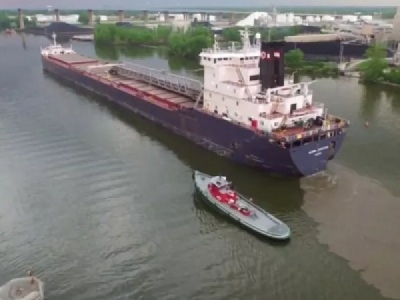
Posted on September 5, 2018
Dredging season began in the lower Fox River this spring as soon as the ice went out, but work is just now poised to begin out in the waters of Green Bay.
While the Fox River dredging is a temporary cleanup operation to rid the river of harmful polychlorinated biphenyls, the bay dredging is an annual battle to keep commodities like coal, petroleum products and limestone flowing into the community.
The American Mariner unloads coal on Tuesday in Green Bay. The Army Corps of Engineers will start dredging the shipping channel in Green Bay so that cargo ships safely navigate to docks along the Fox River.
ADAM WESLEY/USA TODAY NETWORK-WISCONSIN
“We do condition surveys every year, to see which areas have had shoaling, so we can see where the most critical needs are,” said Josh Hachey, chief of operations of the technical services branch of the Army Corps of Engineers, which is responsible for upkeep of Green Bay’s shipping channel.
The channel is supposed to be a minimum of 26 feet deep under low water conditions, but silt is always moving and re-filling, so the Corps contracts annually to have that silt dredged.
Dutch ship MV Arubaborg stops in Green Bay
Last year, the Corps hired Great Lakes Dock and Materials of Muskegon, Mich., to dig up about 86,000 cubic yards from near the mouth of the river and another 38,000 cubic yards farther north into the bay.
This year, Luedtke Dredging Company of Frankfort, Mich., was awarded the $2.4 million contract to remove 287,800 cubic yards from an area nearly six miles out into the bay.
“It’s not the same area every year,” Hachey said. “We’re a little farther out than where we were last year.”
Dredging project benefits wildlife, economy
Dredging will begin in a week or two and is expected to wrap up in mid-November. If weather gets in the way, the company would be required to complete the project in spring. Luedtke will put out a barge equipped with a clamshell crane to do the dredging, and the dredge material will be put on transport barges and hauled and dumped at the Cat Island restoration site.
That’s where a 2.5-mile wave barrier has been built to allow the re-establishment of the three-island archipelago that historically provided habitat for shorebirds and other wildlife. Fine sand dredged from the harbor navigation channel will fill a series of cells to reform the islands that had been eroded away decades ago.
A female piping plover stands in shallow water along the Cat Island Chain in lower Green Bay. Colored leg bands identify the birds by sex and birthplace.
COURTESY OF TOM PRESTBY
Although restoration is expected to take another 20 or 30 years, the islands have already provided habitat to support the resurgence of piping plovers, a shorebird that otherwise hadn’t been seen in the lower bay since before the 1940s.
RELATED: Piping plovers find breeding habitat on Cat Island
Fox River dredging begins as soon as workers can get on the water, but dredging in the shipping channel is scheduled to avoid interfering with spawning fish and nesting birds, Hachey said.
While the dredging benefits wildlife, its real purpose is keeping the shipping channel open, which is crucial to Green Bay’s economic health.
More than 817,200 tons of products have been shipped through the Port of Green Bay this year, according to Port Director Dean Haen. Fourteen port businesses along the three miles of the lower Fox move more than 2 million tons of cargo each year, including coal, limestone and salt, cement, liquid asphalt, tallow and machine parts.
In July alone, that included 235,800 tons of cargo, with much of it being petroleum products.
Petroleum shipments are up 34.7 percent through the Saint Lawrence Seaway traffic, but they’re especially high in Green Bay lately because of the closure of a petroleum pipe between Milwaukee and northeastern Wisconsin, Haen said.
July also saw the import of wood pulp into Green Bay for the first time since 2008, Haen said.
PCB removal will continue
Meanwhile, dredging for PCBs in the Fox River is in its ninth year. It is expected to continue this season until the river freezes and should wrap up in the next year or two.
PCBs were used in the 1960s to produce carbonless copy paper and were spread through the environment through wastewater from the paper recycling process. The chemical was found to be a cancer risk in humans and was banned in the late 1970s.
Since cleanup began in 2009, contractors have removed more than 4.88 million cubic yards of contaminated sediment, processed about half of that, landfilled the rest, and treated nearly 8 billion gallons of water that was returned to the river. Contractors are also capping portions of the river bottom with sand, gravel and rock to keep PCBs from entering the food chain.
Source: Green Bay





